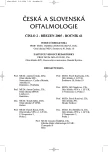New Incision versus Corneal Flap Uncover: Comparison of Two Techniques of Repeated Surgery after Primary LASIK in Myopia
Authors:
M. Horáčková; E. Vlková; M. Hejcmanová
Authors‘ workplace:
Oftalmologická klinika LF MU FN, Brno Bohunice
pfiednosta prof. MUDr. Eva Vlková, CSc.
Published in:
Čes. a slov. Oftal., 61, 2005, No. 2, p. 96-105
Overview
An advantage of the LASIK method is the possibility of repeated surgery in case of residual refractive error after the primary surgery. In the second surgery two techniques are used: the technique of the new incision (secondary LASIK) and the technique of corneal flap uncover.
The authors evaluate the results of the residual refractive errors using both techniques of reoperaration. The cohort constituted of 74 reoperated eyes of 61 patients. The average age was 29.3 ± 7.83 years (18 to 48 years) with the average follow-up period of 6.7 ± 4.7 months (3 to 12 months). The reoperation was performed with the primary refractive error (before the first surgery) less than -3.0 dioptres (D) in 3 eyes, -3.25 to -6,0 D in 24 eyes, and higher than -6 D in 47 eyes of the cohort. Technique of the new incision was chosen in 21 eyes (28.4 %) of the cohort (1st group) and corneal flap uncover in 53 eyes (71.6 %) (2nd group). The residual refractive error before the reoperation was -1.3 D ± 0.94 (standard deviation - SD) combined with -1.17 ± 0.86 (SD) cylindrical dioptres (Dcyl) in the 1st group, and -1.12 D ± 1.27 (SD) combined with -0.83 Dcyl ± 0.64 (SD) in the 2nd one. The primary LASIK surgery, as well as reoperation was in all cases performed by argon – fluoride laser, class IV (Keracor 117 Chiron Technolas).
The authors evaluated the final postoperative refractive error, reduction of its spherical and cylindrical component, uncorrected visual acuity (UCVA), best corrected visual acuity (BCVA) the rate of complications during the surgery, and postoperatively as well. The final postoperative refractive error was in the 1st group -0.35 D ± 0.40 (SD) and -0.56 Dcyl ± 0.67 (SD), and in the 2nd group -0.17 D ± 0.36 (SD) and -0,28 Dcyl ± 0.45 (SD). Reduction of the residual postoperative refractive error after primary LASIK surgery in the spherical part of the error in the new incision technique group was 73.1 % (P = 0.01), and in the corneal flap uncover technique 84.8 % (P = 0.01). The cylindrical part lowered in the 1st group by 52.1% (P = 0.05), and in the 2nd group by 66 % (P = 0.01). Improvement of the uncorrected visual acuity (UCVA) was noticed in the 1st group in 18 eyes (85.7 %), and in the 2nd group in 47 eyes (88.7 %). The best corrected visual acuity remained in most of the cases unchanged – in the group of the new incision technique in 16 eyes of the cohort, and in the corneal flap uncover technique in 36 eyes (67.9 %).
Complications during the surgery and after that were noticed in the 1st group in 4 eyes (19 %), and in the 2nd group in 12 eyes of the cohort (22.6 %). No statistically significant difference in the reduction of the residual refraction error after primary LASIK and complications rate between both mentioned techniques of re-operation were noticed. Both methods may be considered effective and safe.
Key words:
LASIK, new incision, corneal flap uncover, myopia
Labels
OphthalmologyArticle was published in
Czech and Slovak Ophthalmology

2005 Issue 2
Most read in this issue
- Trabeculectomy – Long Term Results
- Inflammatory Pseudotumor of the Orbit
- Bilateral Terrien’s Degeneration Treated by Corneoscleral Graft Transplantation
- The Rabbit IOP and Pupil Values after Application of Aminoacid L-lysine and Antiglaucomatic Timoptol Mixture
